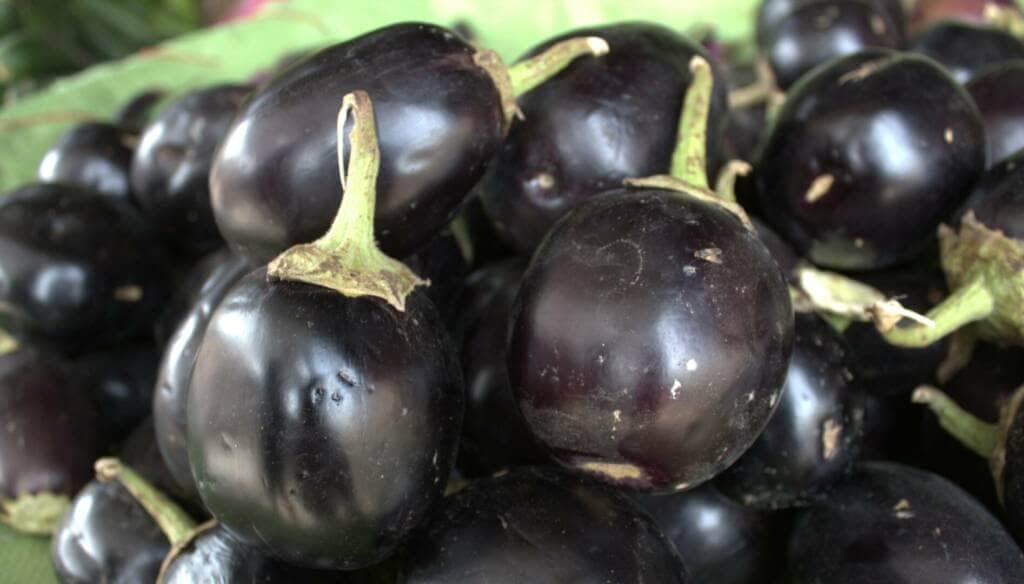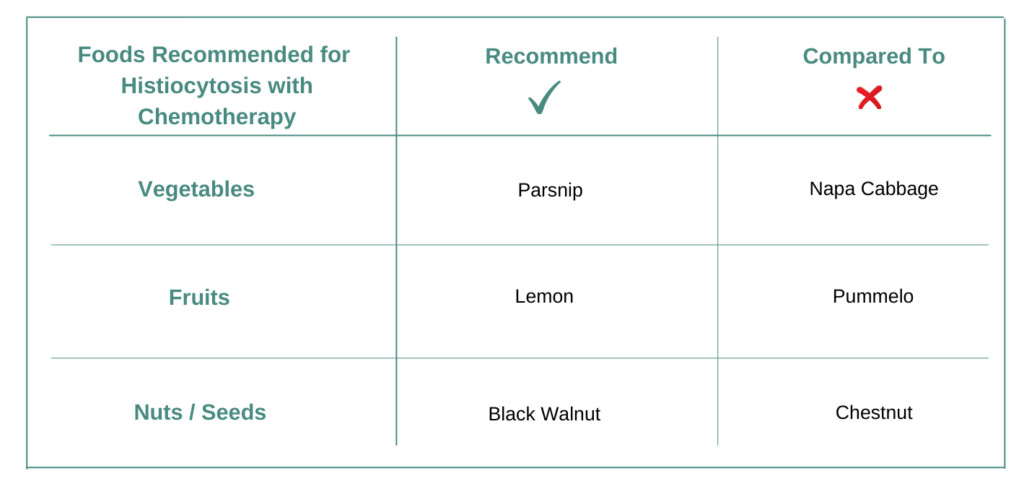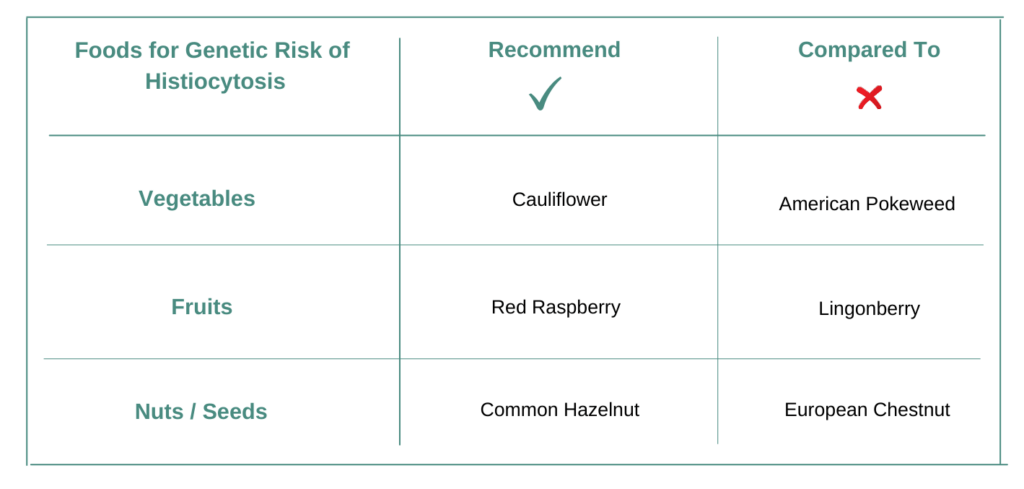Introduction
Foods for Histiocytosis should be personalized for each individual and also must adapt when cancer treatment or tumor genetic change. The personalization and adaptation must consider all the active ingredients or bioactives contained in different foods with respect to cancer tissue biology, genetics, treatments, lifestyle conditions and diet preferences. Hence while nutrition is one of the very important decisions for a cancer patient and individual at risk of cancer to make – how to choose foods to eat is not an easy task.
Histiocytosis is a rare group of disorders characterized by an abnormal accumulation and infiltration of variable numbers of immune cells such as monocytes, macrophages and dendritic cells in the affected tissues. One form of histiocytosis is Langerhans cell histiocytosis (LCH), which primarily affects children and young adults. The symptoms of histiocytosis can vary depending on the type and organs involved, but commonly include bone pain, skin rashes, and organ dysfunction. Pediatric patients with high-risk LCH have a nearly 90% chance of survival. Treatment for histiocytosis typically involves a multidisciplinary approach, including chemotherapy, radiation therapy, and targeted therapies. Treatment decisions are based on the type, site and extent of the disease; the organs involved; biologic factors; the genetics of the disease and a host of other factors. For instance, patients with high-risk LCH must receive at least 1 year of combination chemotherapy. However, the optimal treatment for LCH is not established and it is recommended that the treatment be conservative and limited to individuals with constitutional symptoms such as pain, fever, failure to thrive and vital organ disorder, as well as those at risk for CNS (central nervous system) involvement.
For Histiocytosis does it matter what vegetables, fruits, nuts, seeds one eats?
A very common nutrition question asked by cancer patients and individuals at-genetic risk of cancer is – for cancers like Histiocytosis does it matter what foods I eat and which I do not? Or if I follow a plant-based diet is that enough for cancer like Histiocytosis?
For example does it matter if vegetable Parsnip is consumed more compared to Napa Cabbage? Does it make any difference if fruit Pummelo is preferred over Lemon? Also if similar choices are made for nuts/seeds like Black Walnut over Chestnut and for pulses like Chickpea over Common Bean. And if what I eat matters – then how does one identify foods which are recommended for Histiocytosis and is it the same answer for everyone with the same diagnosis or genetic risk?
Yes! Foods you eat matters for Histiocytosis!
Food recommendations may not be the same for everyone and can be different even for the same diagnosis and genetic risk.

All foods (vegetables, fruits, nuts, seeds, pulses, oils etc.) and nutritional supplements are made up of more than one active molecular ingredient or bio-actives in different proportions and quantities. Each active ingredient has a unique mechanism of action – which can be activation or inhibition of different biochemical pathways. Simply stated foods and supplements which are recommended are those which do not cause an increase of molecular drivers of cancer but reduce them. Else those foods should not be recommended. Foods contain multiple active ingredients – hence when evaluating foods and supplements you need to consider the impact of all active ingredients cumulatively rather than individually.
For example Pummelo contains active ingredients Lycopene, Protocatechuic Acid, Caffeine, Curcumin, Quercetin. And Lemon contains active ingredients D-limonene, Linalool, Protocatechuic Acid, Caffeine, Curcumin and possibly others.
A common mistake made when deciding and choosing foods to eat for Histiocytosis – is to evaluate only selected active ingredients contained in foods and ignore the rest. Because different active ingredients contained in foods may have opposing effects on cancer drivers – you cannot cherry pick active ingredients in foods and supplements for making a nutrition decision for Histiocytosis.
YES – FOOD CHOICES MATTER FOR CANCER. NUTRITION DECISIONS MUST CONSIDER ALL ACTIVE INGREDIENTS OF FOODS.
Skills Needed for Nutrition Personalization for Histiocytosis?
Personalized nutrition for cancers like Histiocytosis consists of recommended foods / supplements; not recommended foods / supplements with example recipes which prioritize use of recommended foods. An example of personalized nutrition can be seen at this link.
Deciding which foods are recommended or not is extremely complicated, requiring expertise in Histiocytosis biology, food science, genetics, biochemistry along with good understanding of how cancer treatments work and associated vulnerabilities by which the treatments could stop being effective.
MINIMUM KNOWLEDGE EXPERTISE NEEDED FOR NUTRITION PERSONALIZATION FOR CANCER ARE: CANCER BIOLOGY, FOOD SCIENCE, CANCER TREATMENTS AND GENETICS.
Foods to Eat After Cancer Diagnosis!
No two cancers are the same. Go beyond the common nutrition guidelines for everyone and make personalized decisions about food and supplements with confidence.
Characteristics of cancers like Histiocytosis
All cancers like Histiocytosis can be characterized by a unique set of biochemical pathways – the signature pathways of Histiocytosis. Biochemical pathways like RAS-RAF Signaling, DNA Repair, MAPK Signaling, PI3K-AKT-MTOR Signaling are part of the signature definition of Histiocytosis. Each individual’s cancer genetics can be different and hence their specific cancer signature could be unique.
The treatments which are effective for Histiocytosis need to be cognizant of the associated signature biochemical pathways for each cancer patient and individual at genetic risk. Therefore different treatments with different mechanisms of actions are effective for different patients. Similarly and for the same reasons foods and supplements need to be personalized for each individual. Hence some foods and supplements are recommended for Histiocytosis when taking cancer treatment Radiation, and some foods and supplements are not recommended.
Sources like cBioPortal and many others provide population representative patient anonymized data from clinical trials for all cancer indications. This data consists of clinical trial study details like sample size / number of patients, age groups, gender, ethnicity, treatments, tumor site and any genetic mutations.
ARAF, F13A1, ADAMTS1, ACOT1 and PTEN are the top ranked reported genes for Histiocytosis. ARAF is reported in 16.7 % of the representative patients across all clinical trials. And F13A1 is reported in 16.7 %. The combined population patient data cover ages from 37 to 60. 70.8 % of the patient data are identified as men. The Histiocytosis biology along with reported genetics together define the population represented signature biochemical pathways for this cancer. If the individual cancer tumor genetics or genes contributing to the risk are also known then that should also be used for nutrition personalization.
NUTRITION CHOICES SHOULD MATCH WITH EACH INDIVIDUAL’S CANCER SIGNATURE.
Food and Supplements for Histiocytosis
For Cancer Patients
Cancer patients on treatment or on palliative care need to make decisions on food and supplements – for the needed dietary calories, for managing any treatment side effects and also for improved cancer management. All plant-based foods are not equal and choosing and prioritizing foods which are personalized and customized to ongoing cancer treatment is important and complicated. Here are some examples providing guidelines for making nutrition decisions.
Choose Vegetable PARSNIP or NAPA CABBAGE?
Vegetable Parsnip contains many active ingredients or bioactives such as Protocatechuic Acid, Curcumin, Quercetin, Lupeol, Gallic Acid. These active ingredients manipulate various biochemical pathways like MAPK Signaling, DNA Repair and PI3K-AKT-MTOR Signaling and others. Parsnip is recommended for Histiocytosis when ongoing cancer treatment is Radiation. This is because Parsnip modifies those biochemical pathways which have been scientifically reported to sensitize the effect of Radiation.
Some of the active ingredients or bioactives in vegetable Napa Cabbage are Protocatechuic Acid, Curcumin, Lupeol, Formononetin, Daidzein. These active ingredients manipulate various biochemical pathways like MYC Signaling and PI3K-AKT-MTOR Signaling and others. Napa Cabbage is not recommended for Histiocytosis when ongoing cancer treatment is Radiation because it modifies those biochemical pathways which make the cancer treatment resistant or less responsive.
VEGETABLE PARSNIP IS RECOMMENDED OVER NAPA CABBAGE FOR Histiocytosis AND TREATMENT Radiation.
Choose Fruit LEMON or PUMMELO?
Fruit Lemon contains many active ingredients or bioactives such as D-limonene, Linalool, Protocatechuic Acid, Caffeine, Curcumin. These active ingredients manipulate various biochemical pathways like MAPK Signaling, MYC Signaling and PI3K-AKT-MTOR Signaling and others. Lemon is recommended for Histiocytosis when ongoing cancer treatment is Radiation. This is because Lemon modifies those biochemical pathways which have been scientifically reported to sensitize the effect of Radiation.
Some of the active ingredients or bioactives in fruit Pummelo are Lycopene, Protocatechuic Acid, Caffeine, Curcumin, Quercetin. These active ingredients manipulate various biochemical pathways like DNA Repair, MYC Signaling and PI3K-AKT-MTOR Signaling and others. Pummelo is not recommended for Histiocytosis when ongoing cancer treatment is Radiation because it modifies those biochemical pathways which make the cancer treatment resistant or less responsive.
FRUIT LEMON IS RECOMMENDED OVER PUMMELO FOR Histiocytosis AND TREATMENT Radiation.
Choose Nut BLACK WALNUT or CHESTNUT?
Black Walnut contains many active ingredients or bioactives such as Protocatechuic Acid, Ellagic Acid, Curcumin, Myricetin, Quercetin. These active ingredients manipulate various biochemical pathways like MAPK Signaling, MYC Signaling and PI3K-AKT-MTOR Signaling and others. Black Walnut is recommended for Histiocytosis when ongoing cancer treatment is Radiation. This is because Black Walnut modifies those biochemical pathways which have been scientifically reported to sensitize the effect of Radiation.
Some of the active ingredients or bioactives in Chestnut are Lycopene, Protocatechuic Acid, Ellagic Acid, Caffeine, Curcumin. These active ingredients manipulate various biochemical pathways like DNA Repair, MYC Signaling and PI3K-AKT-MTOR Signaling and others. Chestnut is not recommended for Histiocytosis when ongoing cancer treatment is Radiation because it modifies those biochemical pathways which make the cancer treatment resistant or less responsive.
BLACK WALNUT IS RECOMMENDED OVER CHESTNUT FOR Histiocytosis AND TREATMENT Radiation.

For Individuals with Genetic Risk of Cancer
The question asked by individuals who have genetic risk of Histiocytosis or familial history is “What Should I Eat Differently from Before?” and how they should choose foods and supplements to manage risks of the disease. Since for cancer risk there is nothing actionable in terms of treatment – decisions of foods and supplements become important and one of the very few actionable things which can be done. All plant-based foods are not equal and based on identified genetics and pathway signature – the choices of food and supplements should be personalized.
Choose Vegetable CAULIFLOWER or AMERICAN POKEWEED?
Vegetable Cauliflower contains many active ingredients or bioactives such as Curcumin, Lupeol, Daidzein, Formononetin, Beta-sitosterol. These active ingredients manipulate various biochemical pathways like MAPK Signaling, RAS-RAF Signaling, MYC Signaling and PI3K-AKT-MTOR Signaling and others. Cauliflower is recommended for risk of Histiocytosis when associated genetic risk is ACOT1. This is because Cauliflower increases those biochemical pathways which counteract the signature drivers of it.
Some of the active ingredients or bioactives in vegetable American Pokeweed are Apigenin, Curcumin, Quercetin, Lupeol, Caffeic Acid. These active ingredients manipulate various biochemical pathways like Oncogenic Cancer Epigenetics and Complement Cascade and others. American Pokeweed is not recommended when risk of Histiocytosis when associated genetic risk is ACOT1 because it increases the signature pathways of it.
VEGETABLE CAULIFLOWER IS RECOMMENDED OVER AMERICAN POKEWEED FOR ACOT1 GENETIC RISK OF CANCER.
Choose Fruit RED RASPBERRY or LINGONBERRY?
Fruit Red Raspberry contains many active ingredients or bioactives such as Curcumin, Ellagic Acid, Quercetin, Lupeol, Daidzein. These active ingredients manipulate various biochemical pathways like MAPK Signaling, RAS-RAF Signaling, MYC Signaling and PI3K-AKT-MTOR Signaling and others. Red Raspberry is recommended for risk of Histiocytosis when associated genetic risk is ACOT1. This is because Red Raspberry increases those biochemical pathways which counteract the signature drivers of it.
Some of the active ingredients or bioactives in fruit Lingonberry are Curcumin, Quercetin, Lycopene, Lupeol, Resveratrol. These active ingredients manipulate various biochemical pathways like P53 Signaling and Complement Cascade and others. Lingonberry is not recommended when risk of Histiocytosis when associated genetic risk is ACOT1 because it increases the signature pathways of it.
FRUIT RED RASPBERRY IS RECOMMENDED OVER LINGONBERRY FOR ACOT1 GENETIC RISK OF CANCER.
Choose Nut COMMON HAZELNUT or EUROPEAN CHESTNUT?
Common Hazelnut contains many active ingredients or bioactives such as Curcumin, Quercetin, Lycopene, Lupeol, Caffeic Acid. These active ingredients manipulate various biochemical pathways like MAPK Signaling, RAS-RAF Signaling, Extracellular Matrix Remodelling and PI3K-AKT-MTOR Signaling and others. Common Hazelnut is recommended for risk of Histiocytosis when associated genetic risk is ACOT1. This is because Common Hazelnut increases those biochemical pathways which counteract the signature drivers of it.
Some of the active ingredients or bioactives in European Chestnut are Apigenin, Curcumin, Ellagic Acid, Quercetin, Lupeol. These active ingredients manipulate various biochemical pathways like Oncogenic Cancer Epigenetics and Complement Cascade and others. European Chestnut is not recommended when risk of Histiocytosis when associated genetic risk is ACOT1 because it increases the signature pathways of it.
COMMON HAZELNUT IS RECOMMENDED OVER EUROPEAN CHESTNUT FOR ACOT1 GENETIC RISK OF CANCER.

In Conclusion
Foods and Supplements chosen are important decisions for cancers like Histiocytosis. Histiocytosis patients and individuals with genetic-risk always have this question: “What foods and nutritional supplements are recommended for me and which are not?” There is a common belief which is a misconception that all plant-based foods could be beneficial or not but would not be harmful. Certain foods and supplements can interfere with cancer treatments or promote molecular pathway drivers of cancer.
There are different types of cancer indications like Histiocytosis, each with different tumor genetics with further genomic variations across each individual. Further every cancer treatment and chemotherapy has a unique mechanism of action. Each food like Parsnip contains various bioactives in different quantities, which have an impact on different and distinct sets of biochemical pathways. The definition of personalized nutrition is individualized food recommendations for the cancer indication, treatments, genetics, lifestyle and other factors. Nutrition personalization decisions for cancer require knowledge of cancer biology, food science and an understanding of different chemotherapy treatments. Finally when there are treatment changes or new genomics is identified – the nutrition personalization needs re-evaluation.
The addon nutrition personalization solution makes the decision making easy and removes all the guesswork in answering the question, “What foods should I choose or not choose for Histiocytosis?”. The addon multi-disciplinary team includes cancer physicians, clinical scientists, software engineers and data scientists.
Personalized Nutrition for Cancer!
Cancer changes with time. Customize and modify your nutrition based on cancer indication, treatments, lifestyle, food preferences, allergies and other factors.
References
- Gct Msk 2020
- D-Limonene modulates inflammation, oxidative stress and Ras-ERK pathway to inhibit murine skin tumorigenesis.
- Preventive effects of butyric acid, nicotinamide, calcium glucarate alone or in combination during the 7, 12-dimethylbenz (a) anthracene induced mouse skin tumorigenesis via modulation of K-Ras-PI3K-AKTpathway and associated micro RNAs.
- Imperatorin suppresses proliferation and angiogenesis of human colon cancer cell by targeting HIF-1α via the mTOR/p70S6K/4E-BP1 and MAPK pathways.
- Paederia foetida induces anticancer activity by modulating chromatin modification enzymes and altering pro-inflammatory cytokine gene expression in human prostate cancer cells.
- Ellagic acid exerts antitumor effects via the PI3K signaling pathway in endometrial cancer.
- Brassinin Represses Invasive Potential of Lung Carcinoma Cells through Deactivation of PI3K/Akt/mTOR Signaling Cascade.
- Kobayashi M and Tojo A, Cancer Sci., 2018
- https://www.cancer.gov/types/langerhans/patient/langerhans-treatment-pdq
- https://emedicine.medscape.com/article/958026-overview; https://www.ncbi.nlm.nih.gov/books/NBK430885
